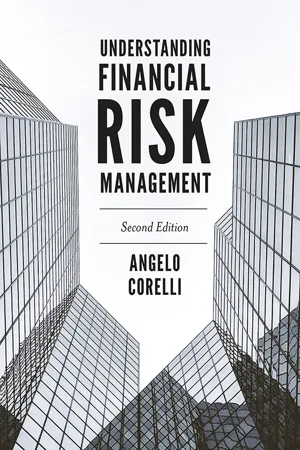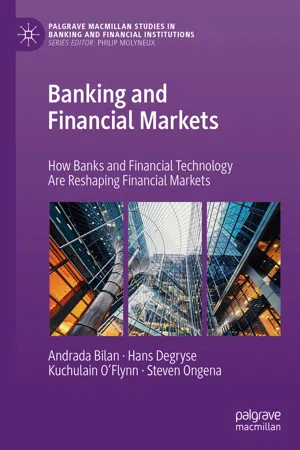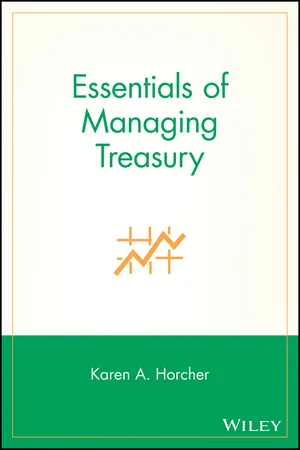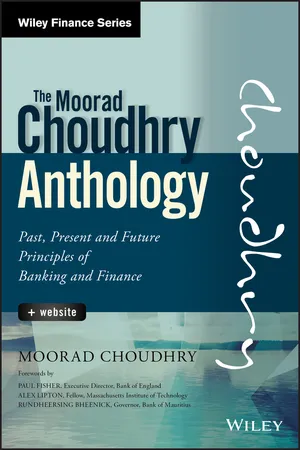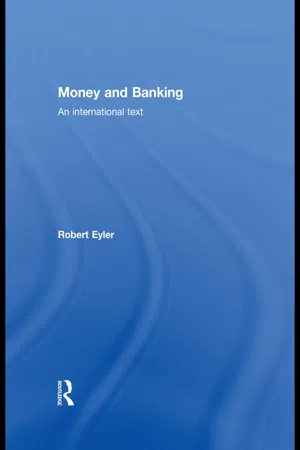Economics
Interest Rate Risk
Interest rate risk refers to the potential for changes in interest rates to negatively impact the value of an investment or asset. It affects both fixed-income securities and loans, as fluctuations in interest rates can lead to changes in the value of these financial instruments. Investors and financial institutions must manage interest rate risk to mitigate potential losses.
Written by Perlego with AI-assistance
Related key terms
6 Key excerpts on "Interest Rate Risk"
- No longer available |Learn more
- Angelo Corelli(Author)
- 2019(Publication Date)
- Emerald Publishing Limited(Publisher)
Chapter 12
Interest Rate Risk
Interest Rate Risk is the risk that changes in the level of interest rates may cause the market value of a bond to change. Interest Rate Risk increases with time. The longer an investor holds a bond, the higher the risk.Fluctuations in interest rates have an impact on the profitability of any business, making necessary to manage Interest Rate Risk. For bond investors, rising interest rates mean falling bond prices, while declining interest rates mean rising bond prices. In general, the prices of long term and low-yield bonds have higher sensitivity to interest rate changes.Excessive Interest Rate Risk can translate in a significant threat to the earnings and capital base of any financial institution. Changes in interest rates affect earnings by changing the net interest income and the level of interest-sensitive income and expenses.Shifts in the yield curve have an impact on both short-term and long-term financial positions. Financial derivatives like interest rate swaps, caps and floors, and swaptions, represent a source of interest change, and their value fluctuates with interest rates.Financial institutions are concerned about the interest rates on assets and liabilities resetting at different times. The assessment of Interest Rate Risk is a very large topic at banks, credit unions, financial companies, and among regulators. - eBook - ePub
Banking and Financial Markets
How Banks and Financial Technology Are Reshaping Financial Markets
- Andrada Bilan, Hans Degryse, Kuchulain O’Flynn, Steven Ongena(Authors)
- 2019(Publication Date)
- Palgrave Macmillan(Publisher)
Further, there is heterogeneity in banks’ exposure to Interest Rate Risk with some banks benefiting from an increase in interest rates, which creates a redistributive effect of monetary policy within the banking industry (Hoffmann et al. 2018). The literature further shows that banks do indeed use interest rate derivatives to manage their on-balance sheet exposure and that the extent to which they hedge depends on bank characteristics and derivative market conditions (Purnanandam 2007 ; Esposito et al. 2015 ; Hoffmann et al. 2018). Finally, the literature finds that a bank’s decision to manage and method of managing Interest Rate Risk affects the transmission of monetary policy (Purnanandam 2007 ; Gomez et al. 2016 ; Hoffmann et al. 2018), the value of its equity (Flannery and James 1984b ; English et al. 2018), its lending behaviour, and, hence, the investment and employment decisions of the firms to which they lend (Gomez et al. 2016). The remainder of this chapter is organized as follows: we begin by reviewing the data sources and methodologies employed in the Interest Rate Risk in banking literature. We continue by discussing the literature that seeks to uncover the following: (1) If and why banks are exposed to Interest Rate Risk. (2) How and why banks manage Interest Rate Risk. (3) What the consequences are of banks’ decision to manage Interest Rate Risk for the transmission of monetary policy and for the firms to which they lend. 3.1 Data To conduct an analysis on bank’s Interest Rate Risk exposure, researchers need to estimate the degree to which banks are affected by changes in the interest rate. To do this, researchers need detailed information on the maturity of banks’ assets and liabilities. A common measure for banks’ on-balance sheet interest rate exposure is the income gap, that is, the difference between the bank’s assets that mature (or reprice) within a year and its liabilities that mature (or reprice) within a year - eBook - ePub
- Karen A. Horcher(Author)
- 2011(Publication Date)
- Wiley(Publisher)
Absolute Interest Rate Risk arises from exposure to a directional (up or down) change in interest rates. Most organizations monitor absolute Interest Rate Risk closely as part of their risk assessments, due to its visibility and potential for affecting profitability.Yield Curve Risk
Yield curve risk results from changes in the relationship between shortand long-term interest rates. In a normal interest rate environment, the yield curve has an upward-sloping shape to it. Longer-term interest rates are higher than shorter-term interest rates because of higher risk to the lender.The steepening or flattening of the yield curve changes the interest rate differential between maturities, which can impact borrowing and investment decisions and therefore profitability.Reinvestment or Refunding Risk
Reinvestment or refunding risk arises when investment maturities (or debt maturities) occur during periods of unfavorable interest rates. As a result, funds are reinvested (or debt refinanced) at market rates that are worse than forecast, impacting profitability. The inability to forecast the rollover rate with certainty has the potential to impact overall profitability of the investment or project. Reinvestment or refunding risk is closely related to absolute Interest Rate Risk but applies to a specific future requirement.Embedded Options Risk
Embedded options provide securities holders or contract participants with rights that can introduce risk to the granting party. For example, the ability to repay a loan prior to its maturity is an option. If the loan can be repaid without a fee, then the granting party has a risk that the loan will be paid at an inopportune time.Foreign Exchange Risk
Foreign exchange risk arises through various sources, including transactions, translation of financial statements, and the activities of competitors. Foreign exchange issues are discussed in more detail in Chapter 4.Transaction Risk
Transaction risk arises from transactions reported in an organization’s income statement. It exists as a result of purchases of inventory from suppliers and vendors, contractual payments, royalties or license fees, and sales to customers in currencies other than the domestic one. Organizations that buy or sell products and services denominated in a foreign currency, including companies with operations or subsidiaries in other countries, typically are exposed to transaction risk. - eBook - ePub
The Moorad Choudhry Anthology
Past, Present and Future Principles of Banking and Finance
- Moorad Choudhry(Author)
- 2018(Publication Date)
- Wiley(Publisher)
© Bloomberg L.P. Used with permission. All rights reserved.The “Default Adj Spread” field shows the number of basis points by which the CDS curve would need to be moved in order to equate the theoretical price to the market price. In this case we see that this adjustment is around 8.5 basis points.Reproduced from Bank Asset and Liability Management (2007)UNDERSTANDING AND MANAGING MARKET AND INTEREST‐RATE RISKS
In this chapter, we introduce the concept of interest and market risk in a banking operation. These risks differ from credit risk, and instead relate to how changes in interest rates and prices for market instruments affect the profitability and value of a bank. A bank can be extremely effective at managing its credit portfolio, but still perform poorly if it fails to manage its interest‐rate and market risk. That said, credit risk remains by far the main type of risk exposure for the majority of the world's retail banks. Most banks run very little genuine market risk, the exception of course are the large global investment banks which routinely manage trading books.Interest‐Rate Risk and Interest‐Rate Risk Management
Banks provide loans to customers, funding these loans with deposits, inter‐bank borrowing, debt issuance, and capital. In the process, interest‐rate risk arises on the balance sheet in a number of forms. While loans can be sold or securitised, the vast majority are retained and are not characterised as trading book assets managed with a market risk approach, as they are banking book assets.Forms of Interest‐Rate Risk The forms of interest‐rate risk are as follows:- Gap Risk: assets (generally loans) do not match liabilities (funding) in terms of tenure, duration, and currency. Where assets and liabilities are mismatched, adverse interest rate movements can lead to profitability being reduced or eliminated, and, in extreme situations, losses can arise;
- eBook - ePub
- E. R. Yescombe(Author)
- 2013(Publication Date)
- Academic Press(Publisher)
Chapter 10Macro-Economic Risks
External macro-economic risks (also known as financial risks), namely changes in interest rates (§10.3), inflation (§10.4), and currency exchange-rates (§10.5), do not relate to the project in particular, but to the economic environment in which it operates. These risks need to be analyzed and mitigated (hedged) in the same way as the specific commercial risks discussed in the previous chapter. Also, a mismatch between a short-term loan and a long-term project is another form of macro- economic risk (§10.6).However before looking at these macro-economic risks in detail, some basic financial concepts which lie behind calculations of the effect of these risks, as well as other cash-flow related issues in following chapters, are reviewed. In summary, these all relate to adjusting cash-flow calculations for the time value of money (§10.2).Keywords
Macro-economic risks; financial risks; interest rates; inflation; currency exchange rates; hedging; mismatch; discounted; cash flow; NPV; IRR; DCF§10.1 Introduction
External macro-economic risks (also known as financial risks), namely changes in interest rates (§10.3 ), inflation (§10.4 ), and currency exchange-rates (§10.5 ), do not relate to the project in particular, but to the economic environment in which it operates. These risks need to be analyzed and mitigated (hedged) in the same way as the specific commercial risks discussed in the previous chapter. Also, a mismatch between a short-term loan and a long-term project is another form of macro-economic risk (§10.6 ).However before looking at these macro-economic risks in detail, some basic financial concepts which lie behind calculations of the effect of these risks, as well as other cash-flow related issues in following chapters, are reviewed. In summary, these all relate to adjusting cash-flow calculations for the time value of money (§10.2 - eBook - ePub
Money and Banking
An International Text
- Robert Eyler(Author)
- 2009(Publication Date)
- Routledge(Publisher)
2 Interest rates and financial marketsIntroduction
Interest rates represent prices of every economic action because they represent both opportunity costs for the use of goods, services and inputs and connect time periods to each other. The sacrifice of consumption today must come with a reward, and consuming today must have its cost. There are many interest rates, one for every asset that exists. The “price” of an asset is in part determined by an interest rate. Interest rates are used in business plans to discount the future, as income to those who have deposited money, purchased stocks and bonds, and to those who make a loan. It is a cost to those who borrow, the cost of consuming more than you can afford at a given time. It is also the cost of not buying something that could produce income. We can summarize the interest rate’s definition generally in four ways:• The revenue from lending or not consuming; • The cost of borrowing or consuming; • The opportunity cost of holding money as cash; and • A measure of time preference concerning consumption.Interest rates come in many forms, all with the same basic set-up. An interest rate includes measures of risk, both general and very specific. When you borrow money, the rate at which you borrow is the nominal rate. This rate is the stated interest cost or return of a financial investment. There is also a real rate, but what separates the two? The difference between nominal and real variables in economics has to do initially with inflation, or purchasing power erosion, and other risks. In its most basic form, a nominal interest rate has the following equation:R = r + P(2.1) where R is a nominal rate, r is the associated real rate and P
Index pages curate the most relevant extracts from our library of academic textbooks. They’ve been created using an in-house natural language model (NLM), each adding context and meaning to key research topics.
